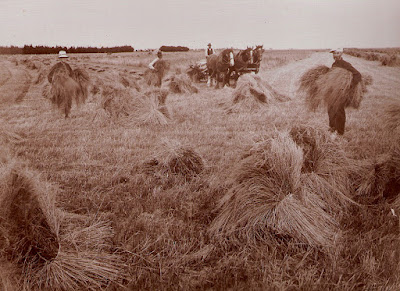 |
| Harvest Thanksgiving Display, Lesmahagow Parish Church [Church of Scotland], Lanarkshire, Scotland, pre 1908 [From my own collection] |
The annual Church celebration of Harvest Thanksgiving or Harvest Festival traditionally takes place in Great Britain on the Sunday closest to the Autumn equinox. In the Southern Hemisphere this celebration naturally takes place in March. While the celebration of Harvest Festival is a relatively modern element of Protestant Church worship such celebrations have taken place since time immemorial.
 |
| "A Dancing Bacchante at Harvest Festival" by Sir Lawrence Alma-Tadema, 1880 [Source : Wikipaintings] |
In ancient Egypt, a statue of Min, the god of vegetation and fertility, would be erected on the harvested fields. There was a parade which even the Pharaoh participated in, as well as music, dance and sport. It is said that the farmers pretended to be sad and wept when they cropped the corn, to deceive and appease the spirits of the earth.
 |
| "The Cadence [passage or progression] of Autumn", by Evelyn de Morgan, 1905 [Source : Wikipedia] |
The ancient Romans celebrated the Harvest Festival of "Cerelia" on the 4th October paying tribute to Ceres, the Goddess of agriculture and the grain harvest. Offerings of the first fruits of the harvest as well as pigs were made to Ceres, the celebrations including music, parades, games and sports as well as a thanksgiving feast.
 |
| "Bringing in the Harvest", Heddon Bush, New Zealand, 1920's. [From my own collection] |
A harvest "offering" is in fact mentioned in the Bible :
"In the course of time Cain brought some of the fruits of the soil as an offering to the LORD. But Abel brought fat portions from some of the first born of his flock. The Lord looked with favour on Abel and his offering, but on Cain and his offering he did not look with favour."
- Genesis 4:3-5 (clicking this link provides some insight into these verses)
In Britain, as in other countries, the custom of celebrating the annual harvest, had formed a part of pagan worship for centuries and even the Masonic Lodges included such worship as part of their rituals. When King Henry VIII of England broke away from the Catholic Church in 1534, he ended 'Lammas' [meaning 'loaf mass'], the practice of celebrating Harvest Festival on the 1st August, whereby farmers made loaves of bread from the new wheat crop and gave them to their local church. The loaves were then used during a special mass thanking God for the harvest. Thereafter farmers continued to celebrate the succesful harvest with a feast on Michaelmas Day, generally by cooking a stuffed goose.
 |
| The 53 surviving English Pilgrims celebrating Harvest Thanksgiving outdoors at Plymouth, [Massachusetts], America in 1621. From an oil painting by Jennie A Brownscombe, 1914 [Source : Wikipedia] |
The modern British church celebration of Harvest Thanksgiving commenced in 1843 when the Rev. Robert Hawker of the Anglican Church at Morwenstow in Cornwall, England invited his parishioners to a special thanksgiving service to celebrate the succesful harvest. Victorian hymns such as "We plough the fields and scatter" and "Come ye thankful people, come" then helped to popularise the celebration of the harvest thanksgiving which soon spread around the country and as an accepted part of Protestant Church worship including within the Church of Scotland. Additionally it became the custom to decorate churches with home-grown produce specifically for the Harvest Festival service.
"Now with your joyous tribute come,
And taste, at length, the bliss that springs
From the deep, grateful sense of things :
Let heaven's high praises wide be heard,
And every heart to sing be stirred."
[Waiareka Harvest Festival, Otago, New Zealand 17.3.1880]
 |
| The harvest drying in the sun, Heddon Bush, New Zealand, c.1920's |
"One great lesson harvest teaches,
is that it yields only what has been sown.
Our great Master and Teacher taught us to
expect the same in our lives"
["The Outlook", Presbyterian Church of New Zealand, 1902]
- Various Internet sources
- Images are only from my own collection where specifically noted and may be freely copied provided a link is given back to this site.





No comments:
Post a Comment